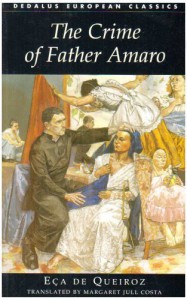5th Commandment: "The Crime of Father Amaro" by Eça de Queiroz, Margaret Jull Costa (translator)

Re-read Project. Read originally in Portuguese in the 80s in my Eça de Queiroz phase.
“Her old religious devotion was reborn, full of sentimental fervour; she felt an almost physical love for the Church; she would have liked to embrace and to plant lingering kisses on the altar, the organ, the missal, the saints, on heaven itself, because she made no real distinction between them and Amaro; they seemed to her mere appendages of his being.”
In “The Crime of Father Amaro” by Eça de Queiroz, translated by Margaret Jull Costa.
I remember my feelings when I first read it. My take is quite different.
For starters, let me just state that I was raised a catholic and I'm still a practicing one.
Since the 80s I learnt a few more things along the way, namely that the first pope (Peter) was married and so were many subsequent ones. In the Greek Church, parish priests are required to marry, primarily to head off problems like the ones depicted in this classic of Portuguese literature. In 2 Corinthians, Paul says it is better to marry than to burn with sexual desire and risk "fornication". This biblical injunction was one reason the protestants dropped the requirement like a stone. The original reason for priestly celibacy is that priests were handing down their offices to sons, taking them out of church hands. Concubinage was winked at partially because any children would be illegitimate and thus could not inherit. The pope who declared celibacy the rule was warned about the problems it would generate, which we see to this day. I no longer believe "The Crime of Father Amaro" was an attack on Catholicism, neither to Catholics in general, but as an attack to corrupt people and corrupt institutions.
If you're into Portuguese Literature, Catholicism, and The Holy Roman Church, read on.
 3
3
 2
2



